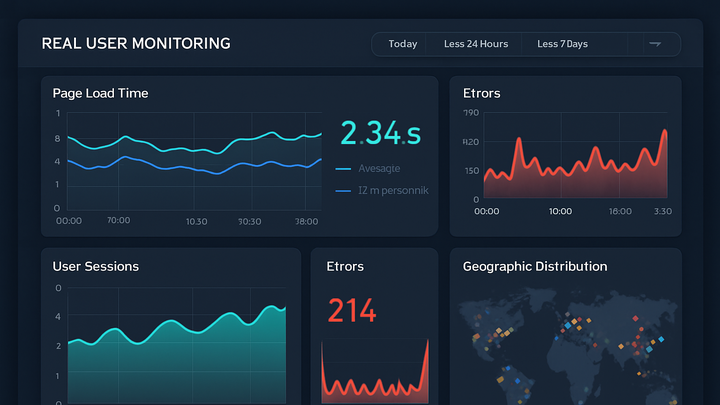Published on 2025-06-22T09:13:18Z
What is Real User Monitoring (RUM)? Examples of Real User Monitoring
Real User Monitoring (RUM) is a technique used in analytics to track and analyze the interactions and performance metrics of actual users on your website or application. Unlike synthetic monitoring, which uses scripted interactions from controlled environments, RUM passively collects data from real sessions, providing authentic insights into page load times, resource usage, errors, and user behavior. RUM helps teams uncover performance bottlenecks, enhance user experience, and prioritize fixes based on real-world impact. Modern analytics platforms like PlainSignal and GA4 support RUM, making it accessible and scalable for businesses of all sizes. By leveraging RUM, organizations can make data-driven decisions to optimize their digital properties and ensure smooth performance across devices and geographies.
Real user monitoring (rum)
RUM passively captures real user interactions and performance metrics, offering authentic insights into website speed, errors, and user experience.
Overview
An introduction to Real User Monitoring, its purpose, and its role in modern web analytics.
-
Definition of rum
Real User Monitoring (RUM) passively records performance data from real users’ browsers, including page load times, resource usage, and JavaScript errors to provide true insights.
How RUM Works
Explains the end-to-end process of collecting, transmitting, and visualizing data in a RUM setup.
-
Client-side data collection
A JavaScript agent embedded in the user’s browser measures metrics like page load, navigation timing, and interaction events.
-
Data transmission & processing
The collected metrics are sent to a backend via network requests where they are processed, aggregated, and stored.
-
Reporting & visualization
Processed data is visualized in dashboards, allowing analysis of performance trends, user geography, and error rates.
Benefits of RUM
Key advantages of leveraging Real User Monitoring for web performance and user experience.
-
Performance visibility
Gain precise, real-world data on page load times and resource bottlenecks across different devices and browsers.
-
User experience insights
Understand how actual users interact with your site, highlighting frustrating delays or errors that matter to your audience.
-
Issue detection & alerts
Automatically detect performance degradations or spikes in error rates and set up alerts for rapid response.
Implementing RUM with SaaS Tools
Guidelines for setting up RUM with popular SaaS analytics platforms like PlainSignal and Google Analytics 4 (GA4).
-
PlainSignal (cookie-free simple analytics)
PlainSignal offers lightweight, privacy-friendly RUM without cookies, focusing on essential performance metrics in real time.
-
Example tracking code
<link rel="preconnect" href="//eu.plainsignal.com/" crossorigin /> <script defer data-do="yourwebsitedomain.com" data-id="0GQV1xmtzQQ" data-api="//eu.plainsignal.com" src="//cdn.plainsignal.com/plainsignal-min.js"></script>
-
-
Google analytics 4 (GA4)
GA4 includes built-in RUM capabilities through enhanced measurement and user-centric events, offering deep insights into page performance and engagement.
-
Basic GA4 setup
<script async src="https://www.googletagmanager.com/gtag/js?id=GA_MEASUREMENT_ID"></script> <script> window.dataLayer = window.dataLayer || []; function gtag(){dataLayer.push(arguments);} gtag('js', new Date()); gtag('config', 'GA_MEASUREMENT_ID'); </script>
-
